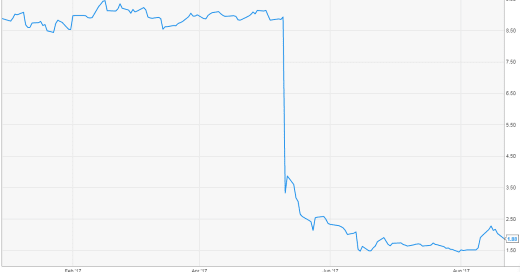
Semi-Case Study / Background on Aimia $GAPFF
Almost exactly a year ago (August 15th, to be exact) I started research on (and took a small position in) Aimia (ticker: GAPFF, disclosure: long the equity and preferreds in roughly equal size). The investment has had ups and downs (the prior management team almost ran the company into the ground through a combination of incompetence and one of the worst transactions I've ever seen, but fortunately some shareholders got involved and brought in a new management team). Today, the company is in one of the weirdest special situations I’ve ever seen: they are balancing two hostile offers (one from Air Canada plus their credit card companies ("the consortium") for their Aeroplan program and one for their Mexican PLM investment) while simultaneously striking partnerships to prep to relaunch their Aeroplan program once Air Canada leaves in 2020.
I wanted to highlight the company because the situation here is extremely rare (I can’t remember anything with two hostile bids on the table before) and it could evolve in a lot of different ways. Both the Air Canada and Aeromexico deals appear to be off the table currently, but I think the strategic value of all of Aimia’s assets are way higher in the hands of their respective bidders than as a standalone, so if I had to guess I’d say eventually everyone comes back to the table and Aimia is broken up and sold (I think the optimal outcome for all parties is for Aimia to sell off all of their parts outside of Aimia and then re-engage with / sell the whole company (which is now basically Aimia and some cash) to the Air Canada consortium as I think that would result in the least tax leakage and highest shareholder value). Still, I could be convinced of anything ranging from the company launching a wildly successful standalone program in a few years to the company flaming out spectacularly once AC leaves the program. FWIW, Aimia board member Mittleman’s Q2’18 letter includes an updated SOTP that pegs Aimia’s value at ~C$10/share, which is significantly above today's price of <C$4.00/share.
Last year I posted a “case study” on Tangoe after it got acquired; in that vein (and with the company currently "in play" and the situation rapidly evolving) I figured I’d post last year’s Aimia write up. So below is my write up from last year (written end of August 2017). With the benefit of hindsight, I think the post was way overoptimistic on several things (in particular, I was early on Aeroplan’s stabilization, way overestimated the value of the international programs, and generally was wrong on management’s urgency for finding a new partner and general competence) but it seems it was relatively spot on in the thing that mattered most: the strategic value of Aeroplan and (some) of its parts. Enjoy! (PS- lest you think I am doing this simply to pat myself on the back, I feel like I have been pretty open with admitting to mistakes in the past and I’ll aim to post some negative case studies in the future; posting this is much more an effort to share knowledge as I did a lot of research into loyalty programs that I think investors might find useful / helpful for general background on the situation, and I've generally found a bit of misinformation / misunderstanding on Aimia and the event set up that this post might help a bit with).
Last year's write up starts below
On May 10th, disaster struck for Aimia shareholders (AIM in Canada; GAPFF in America. Disclosure: long). Air Canada, Aimia’s largest redemption partner, had decided not to renew their partnership; instead, Air Canada was planning on launching their own loyalty program when their contract expired in June 2020. Aimia shares tanked in response as investors projected a bleak future for Aimia without Air Canada. It’s my belief that the massive sell off is an overreaction, and investors today are presented with a unique opportunity to buy what could be a fantastic business at a discount to run off value.
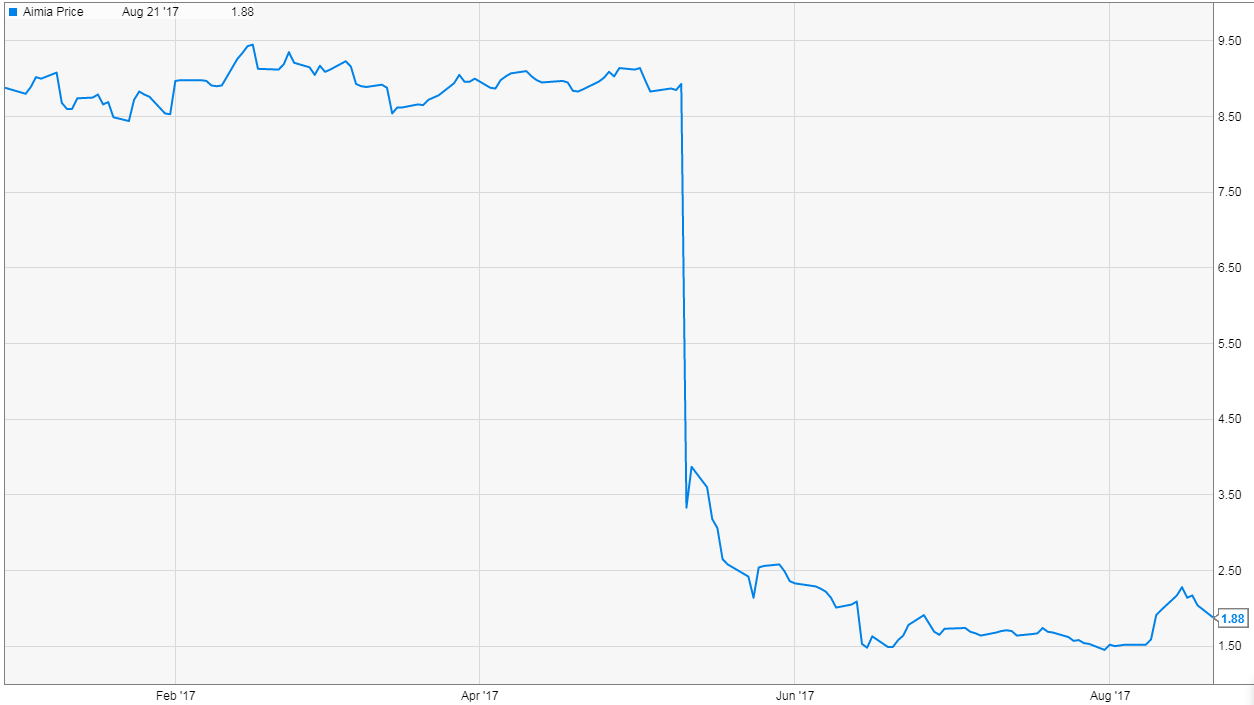
Some basics: Aimia owns and operates loyalty programs and loyalty / marketing analytics. Most of Aimia’s value comes from Aeroplan, Canada’s “premier” coalition loyalty program. A coalition program basically works like this:
A consumer joins the program.
Every time they spend money at a business that participates in the program (a “coalition partner”), that coalition partner buys a loyalty unit (a mile) from Aimia / Aeroplan and puts it into that customer’s Aeroplan account.
Once the customer has accumulated enough miles (~30 months for the average Aeroplan customer), they can cash those miles in for a reward (in general, a flight).
At that point, Aeroplan will buy the reward and give it to the consumer.
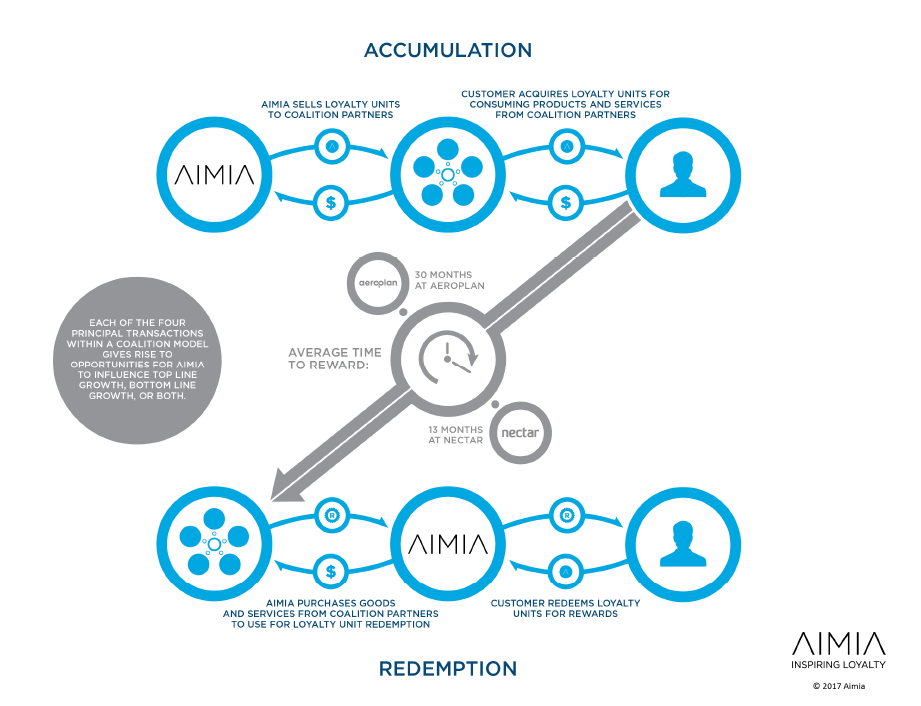
The loyalty program obviously has the potential to be a great business. Aimia collects the cash for the miles up front and doesn’t have to give the customers anything for a long period of time (30 months in the Aeroplan example), creating a massive amount of float. And, much like with gift cards, a significant amount of the miles that consumers generate are never used (known in the industry as “breakage”); since those miles have already been purchased by the coalition partner, that breakage represents basically 100% profit for the loyalty program.
At this point you’re probably wondering: if Aimia is such a good business, then why does Air Canada leaving Aeroplan matter? Well, Air Canada is Canada’s largest airline, and Aeroplan is a loyalty program designed to get people reward flights (notice the “Aero” in their name!). Air Canada represented 11% of Aimia’s gross billings (loyalty units purchased) and 47% of Aimia’s redemptions in 2016; however, those numbers actually understate just how important Air Canada is to Aeroplan, as Aimia is a global company with several different loyalty programs. If we were to just look at the Americas segment (the segment where Aeroplan is located), Air Canada represented 19% of Aimia’s Americas revenue and a whopping 82% of Aimia’s Americas redemptions in 2016. When the numbers are presented like that, you can see why the market is so concerned: not only is Aimia / Aeroplan losing a huge chunk of their revenue, but they are also losing by far their most popular redemption option. What good is a loyalty program designed for people who want flights if the program doesn’t have any flights?
Losing ~20% of Aeroplan’s revenue and ~80% of their redemption options may sound bad, but it may actually undersell the risk to Aeroplan. Remember, getting paid for miles 30 months before consumers redeem those miles creates an incredible amount of float. However, Aimia doesn’t just keep all of the money on their balance sheet; instead, they have historically used that cash to buy back a ton of shares and pay out a lot of dividends. So that massive float represents a real liability that Aeroplan must continually generate cash / more float to replenish. If that float ever were to decrease significantly, Aeroplan may not have enough cash on hand to meet redemptions, which makes Aeroplan vulnerable to a “run on the bank” type scenario where the loss of Air Canada causes all consumers to redeem their miles en masse before Air Canada goes away. At June 30, 2017, Aimia had ~$3.3B CAD in deferred revenue (almost exclusively miles to be redeemed) on their balance sheet. Not all of that is related to Aeroplan given they run several loyalty programs worldwide, but the bulk of the liability is Aeroplan. If everyone rushed to redeem those miles at once, Aimia would be unable to meet that obligation and Aeroplan would collapse. And remember: bank runs can be self-fulfilling, as one person panicking and pulling their money can cause two more, who cause four more, who cause eight more…. Until the whole thing collapses. In the wake of Air Canada pulling out, Globe and Mail ran a series of articles highlighting ways to replace Aeroplan and frequent flyers asked if they should dump Aeroplan, so a bank run is clearly in play here as well.
So clearly losing Air Canada is an existential threat to the Aeroplan program, but I actually think investors today have enough information to determine that the risk of a bank run has passed and there’s a very good chance Aeroplan will remain viable / profitable after Air Canada leaves in 2020.
Let’s start with why I think a bank run is off the table: Aimia already reported Q2’17 results, and while the company saw a slight spike in redemptions immediately after the AC announcement in mid-May, trends returned to normal patterns within a month. Aeroplan also grew miles accumulated during both Q2 and in July 2017. Both numbers are wildly inconsistent with a run on the bank scenario, as a run on the bank would be a self-fulfilling prophecy that saw customers materially decrease miles accumulation (no one would want to accumulate miles while they are trying to pull them out desperately) and rush to redeem before the miles devalued / the program disintegrated (i.e. mile redemption would increase exponentially until the program collapses). Since trends had returned to normal by June, and most of the press relating to the Air Canada exit is in the rearview mirror (lots of press on a plan can increase redemptions both by stoking panic and reminding people they should use up all those miles they have sitting in their account), I think it’s safe to say most of the run on the bank risk has passed.
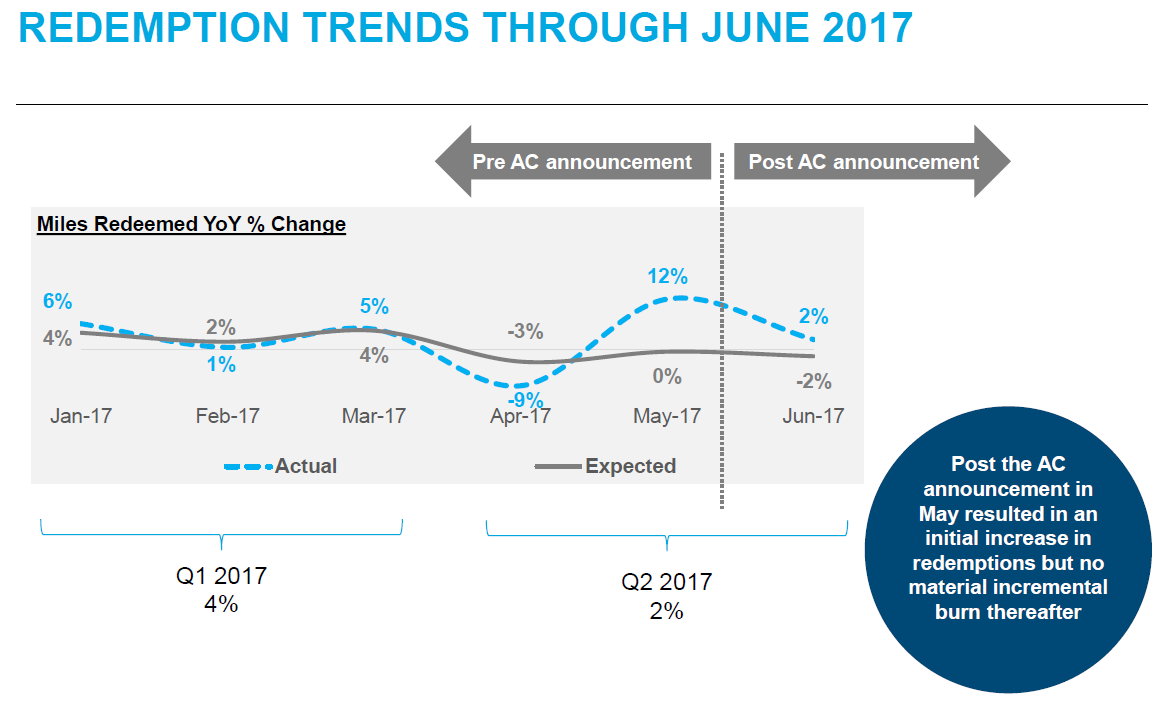
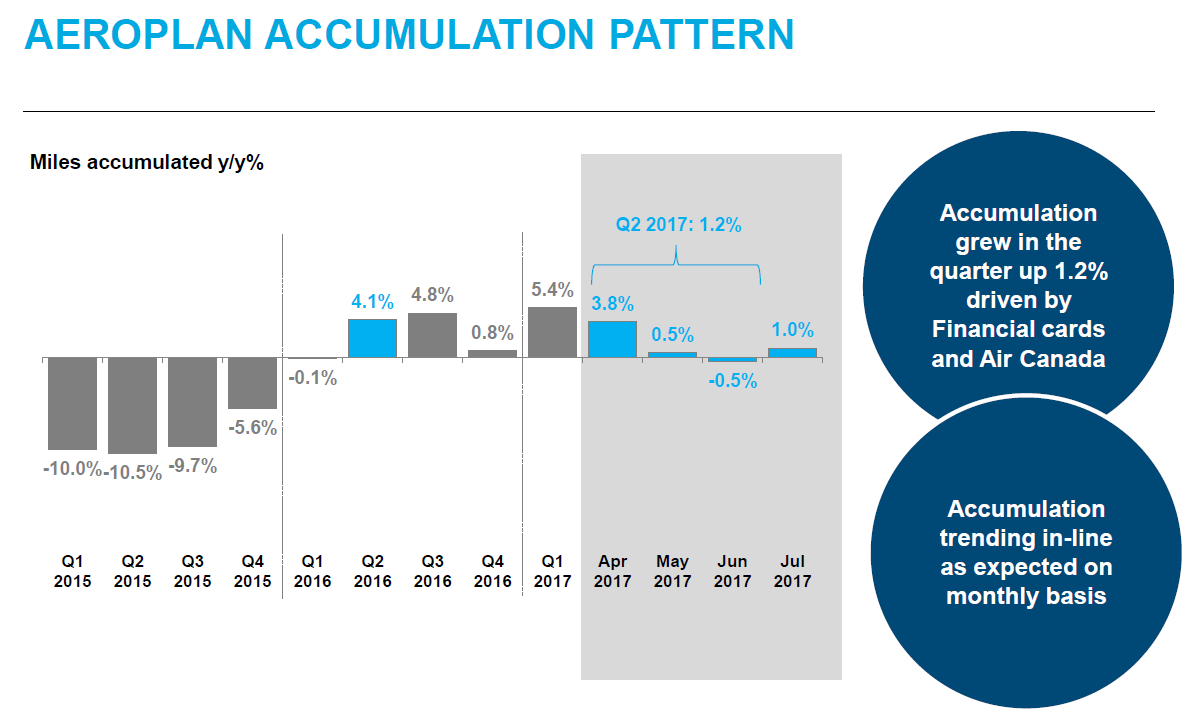
Ok, so run on the bank risk is likely in the rearview mirror. Let’s now talk about why I think Aeroplan will survive Air Canada leaving.
My reasoning here is simple: at its core, a loyalty program is a three sided market with consumers, coalition partners, and redemption partners. Each side has unique needs that can only be met if the other two sides are strong, creating a bit of a chicken / egg problem. Consider:
Consumers: consumers want a redemption option that they can use and benefit from. They also prefer lots of coalition partners so they have plenty of opportunities to earn rewards. Without both, there’s no incentive for the consumer to bother with the hassle of signing up for the program and using it.
Coalition partners: Coalition partners join the program to drive consumers to their stores / business. So, ideally, the consumers in the program will be consumers with a propensity to spend money and who are willing / able to switch providers to get points (i.e. gas stations love loyalty programs, since consumers can easily switch from one location to another. A cable company doesn’t really need one, since consumers so rarely change providers). If the loyalty program doesn’t have any consumers (or doesn’t have the right type of consumers), coalition partners have no incentive to join the program / spend money buying points.
It’s worth noting that, by far, Aeroplan’s most important coalition partners are TD and CIBC, two banks who issues Aeroplan branded credit cards. Combined, the two issued more than 50% of Aeroplan miles in 2016.
While TD, CIBC, and Air Canada are by far Aeroplan’s most important coalition partners, there are plenty of others. Avis, Budget, Costco, Esso, and plenty more.
Maybe it seems silly thinking that a loyalty program can drive traffic, but they definitely do. Dominoes (DPZ) specifically highlights their loyalty program contributing to traffic gains. Maybe that’s a bit apples to oranges versus a rewards focused external loyalty program, but I just highlight it to show that these things do drive consumer behavior.
Redemption partners: The redemption partner should be a business that can really benefit from increased volumes and who is looking to access the consumers in the rewards program. Airlines, casinos, and hotels are all examples of high fixed cost businesses that could benefit from access to the consumers in a loyalty program.
In Aeroplan’s case, Air Canada gave them very preferential terms. Those terms (as well as serving as Air Canada’s loyalty program to begin with) were critical for getting the flywheel going (having super cheap flights attracts consumers, which you can then use to lure in coalition partners). Air Canada set aside 8% of their seat capacity and sold them to Aeroplan at a fixed rate, which allowed Aeroplan to offer flights to their members well below market prices. In addition, Aeroplan could buy more inventory on top of that 8% at a variable discount to published fare prices, and Aeroplan got most favored nations status with other loyalty programs (i.e. no other loyalty program could get flights cheaper than Aeroplan).
Ideally, once all three sides are set up, the loyalty program should become something of a flywheel. Consumers spend lots of money at the coalition partners to get reward miles. The loyalty program directs those consumers to the redemption partners in huge volume; in exchange, the loyalty program gets a group purchasing discount from the redemption partner (i.e. cheaper airfare / hotel rooms). The cheaper tickets lowers the redemption cost, which the loyalty program can pass back to the consumer, resulting in deals the consumer could never get on their own (i.e. the loyalty program’s bargaining power lets them buy a flight for $80 versus $100 retail price, and the consumer can get it for $85 worth of miles). Consumers, eager for access to the cheaper flights / rewards, use the card even more, generating more business for partners and more miles for redemptions, resulting in greater redemption volume, and so on.
So, in the example above, you can see that losing Air Canada as a coalition partner certainly hurts, but the real pain comes from losing Aeroplan’s major redemption partner. Again, Air Canada was ~80% of Aeroplan’s redemptions, so their loss basically destroys the redemption side of the market above. If Aeroplan can’t replace Air Canada, the whole program will eventually collapse.
That’s a big “if”. My working theory is that Aeroplan will be able to replace Air Canada and keep the program successful going. I believe that for two key reasons:
Even though the major redemption partner is gone, the other two sides of Aeroplan’s three sided market (the consumers and the coalition partners) remain firmly in place. On the consumer side, we’ve already seen that consumers continue to use Aeroplan / accumulate miles in Aeroplan’s Q2 results. On the coalition partner side, Aeroplan’s major partners are credit card companies (CIBC and TD) that are contractually locked in to Aeroplan until 2024.
Also worth noting- >50% of Aeroplan billings / miles come from TD and CIBC. Once a credit card starts getting used, it becomes pretty sticky (here’s a survey that notes 19% of people have favored the same card for 10+ years and 15% of people never change their primary card). People are generally lazy about switching cards, and once a credit card is plugged in for autopay (Netflix account, utilities, gym memberships, etc.) or online shopping, consumers generally aren’t changing that card.
While Air Canada leaving Aeroplan is a massive blow for Aeroplan, it won’t be easy for Air Canada to replace that volume. Remember, the airline business is a relatively fixed cost business, and Aeroplan directs a lot of the variable traffic / money. In Canada, Aeroplan spends ~$840m CAD/year on redemption costs. That is a massive amount of money. Aimia’s filings give enough details that some math allows you to get down to roughly how much they paid Air Canada in 2016. That number comes out to ~$690m CAD; since Air Canada is publicly traded, we can see they did ~$13.2B CAD in passenger revenue in 2016. Putting the two together, we know Aeroplan was responsible for more than 5% of Air Canada’s revenue in FY16 and, given Aeroplan is paying a discount for their tickets; they were responsible for an even greater % of Air Canada’s volume (~7.9% of Delta Airline’s miles flown in 2016 were from reward miles redemptions).
So here’s how I see this playing out: Aeroplan can go to Air Canada, West Jet, and any other airline with a decent Canadian presence (Southwest and several other airlines have called Canada “expansion markets”) and push them for purchasing discounts in exchange for directing volume to them. Given the amount of volume Aeroplan is directing, the airlines should be eager to deal with Aeroplan. While overall costs for Aeroplan may end up increasing (the Air Canada deal had a lot of attractive carrots for Aeroplan both because Air Canada was the exclusively airline redemption option for Aeroplan and because Aeroplan was part of Air Canada until the early 2000s), I think they’ll be able to reach a deal that allows them to remain substantially profitable given their purchasing volume.
Obviously the negotiations could play out a bunch of different ways (the iteration above is just one iteration). But my bottom line is I think Aimia will be able to survive those negotiations and remain solidly profitable on the other side. My faith underlying the belief that Aeroplan can successfully get a deal done is driven by the fact Aeroplan owns their members / consumers (the consumer has an account with Aeroplan, their miles are Aeroplan’s miles, Aeroplan has the consumer’s data, etc), and owning the consumer is the most important part of getting one of these three sides markets started. Aeroplan owns the consumer. Remember, consumers have a deep history with Aeroplan (the average member has been with Aeroplan for 10+ years), and Aeroplan has 5m+ active members who, in total, represent more than 10% of Canadian credit card purchase volume. AC leaving Aeroplan doesn’t change any of that. There’s a reason airlines have been known as commodity businesses for decades: all consumers care about when they fly is low cost and convenience. Consumers’ memories are short, and in the end they don’t care if an airline beats them up or if the customer service sucks; consumers just want to buy the cheapest flights at the most convenient times/airports. So whether Aeroplan ultimately puts consumers on a WestJet or Air Canada plane makes no difference to the consumer as long as the Aeroplan miles are readily available as a “free” reward for spending money.
So my underlying belief is that Aeroplan owning the consumer is the most important piece of this equation, and I think we can see confirmatory evidence of that from Aimia’s negotiations with the banks / credit card companies. Way back in 2013, Aimia / Aeroplan had an exclusive banking / credit card deal with CIBC. Negotiations between the two companies hit a standstill, and CIBC was going to let Aeroplan walk. In response, the newly free Aeroplan reached a deal with TD, and CIBC eventually exercised their matching rights and kept ~half of the Aeroplan business while TD acquired the other half. There are a ton of things in here that suggest getting access to Aeroplan’s consumers is incredibly valuable:
Reuters described Aimia as the “clear winner” of the agreements and it’s easy to see why. Not only did Aimia get guaranteed marketing support, a long term contract, and minimum mile purchased requirement, but they also got a >15% boost in the cost per mile to the banks.
TD paid CIBC ~$160m to acquire 550k cardholders accounts (~$290/account) that spent ~$20B annually (this article suggests there were some backend payments too; which would make the ultimate value/customer even higher). TD is paying that just to have a relationship with the Aeroplan consumer.
It’s not just TD; banks clearly crave relationships with these loyalty programs and their customers. This is a different program, but here’s a paid tweet and paid program for the Ritz-Carlton Rewards Cards, which is owned by JPM.
TD talked about the deal a lot when it was announced (they did an M&A call when the joint deal was announced, and they had a conversation at a bank two days later). If you go listen to the calls (they are archived on Bloomberg), you can see TD talked about how consumers are incredibly loyal to the Aeroplan brand, that these are the exact consumers TD targets with credit cards (high spenders with low risk of default who earn a lot of money and tend to carry a balance. TD used the term “high spend, high balance”) and that they couldn’t pass on the opportunity to secure “the most popular travel card in Canada”.
What happens in 2024 if TD / CIBC decide not to renew the Aeroplan contract? If you go back and read the press from when TD was going to pick up Aeroplan without CIBC, it was pretty clear banks were going to come after former CIBC customers hard to get them to switch. Assuming Aeroplan has introduced a decent redemption partner by 2024, would the banks really risk losing Aeroplan customers by ending their Aeroplan deal?
Aimia also hosted call both on announcing the TD deal and announcing the combined TD / CIBC deal. On them, they highlighted that people feel loyalty to Aeroplan, not the card issuer, and that CIBC had tons of success cross selling cardholders other products (banking, mortgages, etc.). Any company is going to claim that their product is the one driving success, but given both the press coverage and the competitive nature of the bidding for Aeroplan’s partnership, it makes sense that the ultimate customer loyalty resides at Aeroplan.
Here’s one quote on this- “the vast majority of people took out credit cards with CIBC because they were aeroplan members and wanted to earn aeroplan miles”
Aimia also cited some studies that suggested 80%+ of cardholders didn’t care about who issued the card; they just wanted Aeroplan cards.
On the TD call, Aimia also discussed negotiating with TD and how both parties negotiated knowing that the Air Canada program expired in 2020.
Speaking on what would happen if they couldn’t reach a deal with AC in 2020, they said “we would have a hugely successful and economically viable program… would be of great interest to other participants in the travel business.”
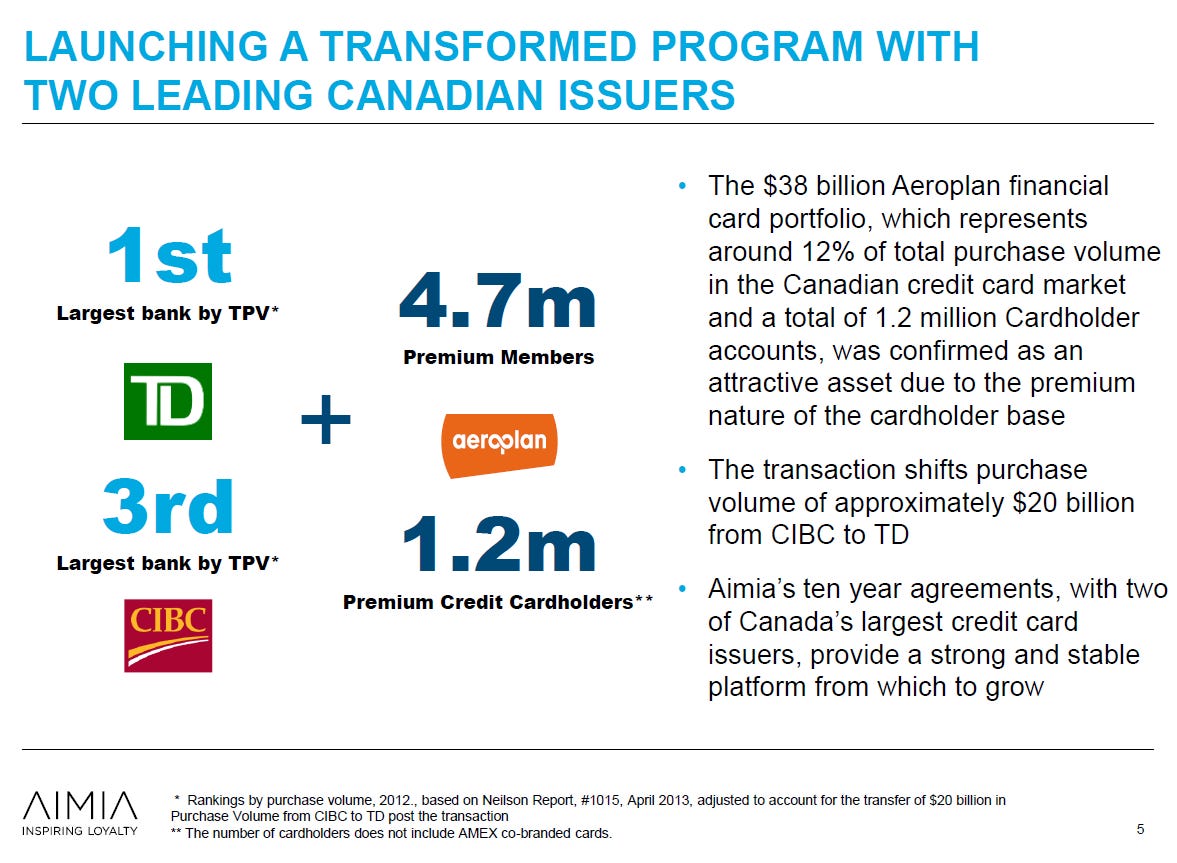
Ok, I feel like I’ve gone deep enough into why I think Aeroplan can survive Air Canada leaving. Let’s talk valuation. Here’s how Aimia presents their balance sheet:
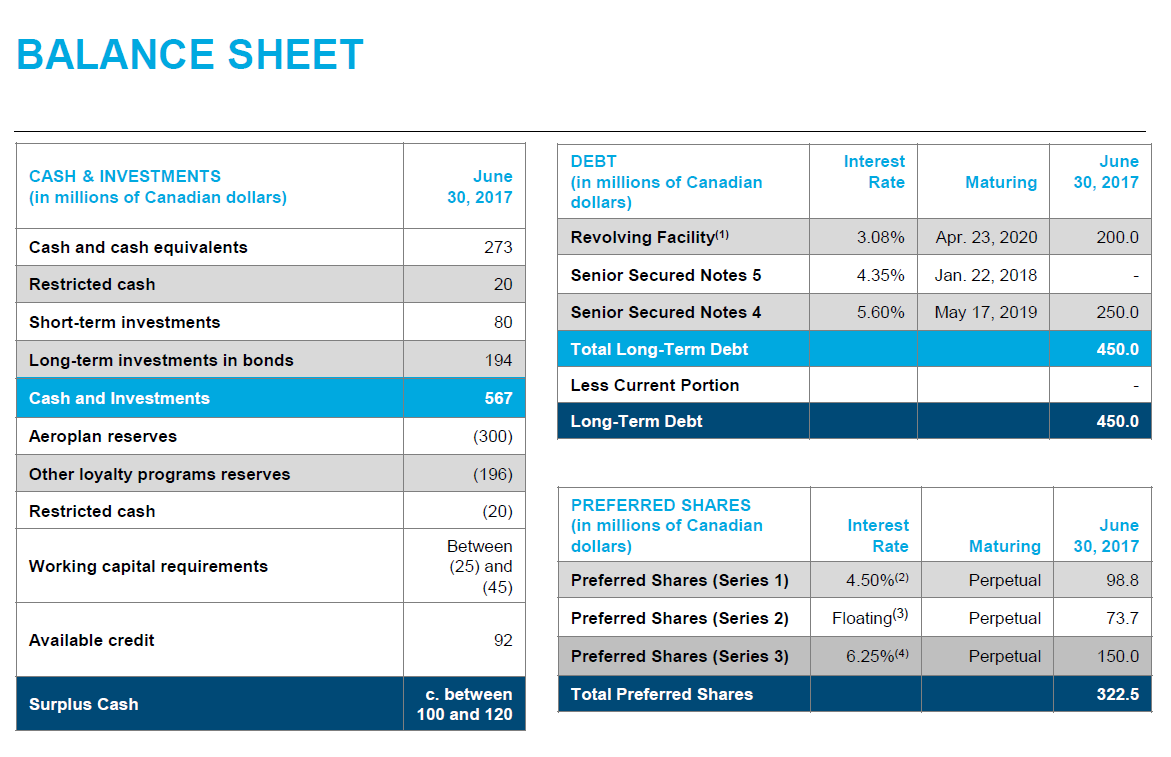
The important thing here is that they have a $300m Aeroplan reserve here. Aimia has ~$3.3B in total deferred revenue liabilities, so this balance sheet is assuming Aimia is a going concern, not a bank run candidate. Assuming that’s right and at today’s share price of ~$2, Aimia’s EV comes out to ~$740m (note: I add pension liabilities to the EV, which aren’t included above):
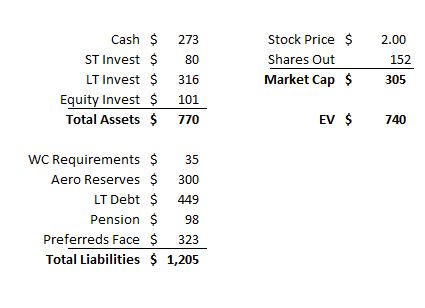
Aimia’s LTM Adj. EBITDA is ~$230m. Here’s how their earnings breakout:
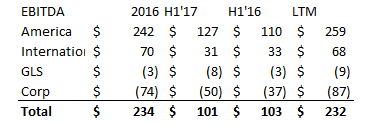
The Adjusted EBITDA number is slightly doubly counting, as it includes ~$27m in equity distributions (mostly in their corporate line). Take that out and we’re buying ~$200m in LTM EBITDA for $740m today. This is a low capex business (~$50m this year and company has suggested that will drop going forward). Combine low capex with the business’ favorable float characteristics (provided they aren’t shrinking / experiencing a run on the bank), and this is a business that should throw off gobs of cash. Assuming business as usual, Aimia should generate at least $150m/year in FCF.
Of course, business isn’t “as usual” with the AC drop coming. How much will losing AC hurt Aimia? Interestingly, on the Q2 call, the CFO responded to a questioner with this line, “as we have said, and as we talked about in the May quarter announcement, if you do the math on the basis of the information that we gave you, you could get to a $200 million impact on adjusted EBITDA. And as you mentioned the impact here of the cost savings will be $70 million annually from 2019 and onwards. So that basically means that you will have margin improvement than cash savings prior to the non-renewal in July 2020 with Air Canada.” Now, I haven’t been able to back into how the CFO got to that number (AC was responsible for ~$200m in booking, and given this is a ~10% EBITDA margin company with 35% gross margins, it’s tough to reconcile how they come to $200m in lost EBITDA, particularly without understanding what they are assuming on redemptions), but it basically implies the Americas segment would still be profitable even after losing AC. Add back the cost cutting and the company would be doing ~$70m/year in EBITDA without any upside from adding a new redemption partner.
Again, I’m not sure if the assumptions behind that $200m in lost EBITDA from AC leaving are accurate. And that $70m assumes international segment earnings remain steady, a somewhat bold assumption given Sainsbury (their major international partner; responsible for >50% of their international billings) has their partnership contract end in 2019. But I do think it helps reinforce that AC leaving doesn’t mean there can’t be a profitable, cash flow generative business here. And I have to think there’s upside to that ~$70m number from striking a good redemption deal.
So this post is already really long, and I think I’ve gone over everything I wanted to cover. My base case here is that I think Aimia will generate several hundred million in FCF over the next few years (enough cash that, when combined with their current cash / equity investments, I think they could pay down all of their debt, all of their preferreds, and almost all of their current market cap by the time the AC contract officially expires). At some point in the near future, they will reach a new redemption partner agreement, likely with AC involved in some way, because the fixed cost nature of redemption partners means they are desperate for Aeroplan to direct massive volume to them. After 2020, Aimia will remain a highly cash generative company, driven by their ownership of valuable customers and their bank / credit card contracts that extend to 2024 (and which I think will renew in some form; again, the customer is owned by Aeroplan and banks want access to those customers).
Potential Catalysts
Acquisition- I have to think there’d be serious interest from a variety of players in acquiring Aimia
Financial- A PE firm would have to be drooling at using Aimia’s massive float to fund a ton of leverage. In addition, they could have a field day selling off all the non-core equity investments.
Air Canada- If I’m right that owning the customer is the key piece of a loyalty program, AC is going to have a lot of difficulty getting their loyalty program up and running. While capturing high value frequent flyers will probably be easy for them, capturing the longer tail of Aimia customers (those who only redeem rewards every two years or so) is going to be difficult. A cynic could look at Air Canada’s decision to provide Aimia with >3 years notice before breaking their contract and think it was designed to drive Aimia’s share price down and make an acquisition more palatable on all ends (for AC because they have to pay a lot less; for Aimia because they are looking at a terrifying future)
ADS / Air Miles- Air Miles is the other big Canadian loyalty program. They’re owned by ADS, which is publicly traded. ADS has been pretty clear that their focus for capital allocation in the near term is M&A; at the Cowen conference in June, they specifically said they were looking to get back into “the acquisition game” and LoyaltyOne (their segment which holds Air Miles) was one of their focuses for M&A. I’d have to think there’d be some synergies between merging the two programs, though it’s possible there are both regulatory and commercial reasons not to attempt it.
New Redemption Partner announcement- I think it’s likely Aeroplan announces a new redemption partner in the near future. Simply getting a new partner and removing the uncertainty associated with not having any should be good for the stock. If I’m right that getting access to these consumers / Aeroplan’s purchasing power gives them a good negotiating position, the deal should be a good one for the company and the announcement could be great for the stock.
Why do I think a deal announcement is coming soon? Management said they are urgently working on finding a new redemption partner, and urgency makes sense. Having lingering uncertainty around your redemption options discourages people from accruing miles / encourages people to redeem before 2020. The company should want to head that risk off.
It’s very possible the new redemption partner involves AC in a significant way. Air Canada’s announcement specifically said they “Canada intends to continue to offer Aimia redemption seats for Aeroplan members after June 2020, with pricing competitive with other third-party rewards programs,” so it’s not like that door is completely closed. Given Aeroplan’s purchasing volume, it would be crazy if the two sides couldn’t find some sort of mutually beneficial agreement.
Odds and ends
I thought this article did a nice job covering both the situation and motivation for all the parties involved in Aeroplan / Air Canada.
Speaking of interesting articles, rereading this article from right before Aeroplan’s IPO is interesting. It talks about how having more partners than just AC is what makes Aeroplan’s business attractive; it also includes some quotes from West Jet that make it seem like they’d very much like to be involved with Aeroplan. That article is over 12 years old, but very interesting.
Run on the bank boosts profits- One other thing that I think is misunderstood about a run on the bank type scenario is that it would probably result in huge profit boosts. There’s only so many Air Canada flights that people want to redeem miles for (i.e. people want to redeem Toronto to Florida), and that limits how many people can redeem. In a true run on the bank, people would need to redeem for things like gift cards, which have way higher margins for Aeroplan. Again, not a complete panacea, but I think it’s very misunderstood.
If you look at the Airmiles expiration fiasco (linked earlier), there are tons of stories about people cashing in miles they’d been saving up for years for giftcards at the last second. That would be very high margin for Aeroplan.
Minimum purchase agreements- The TD / CIBC agreements provide for 5 year volume commitment based on miles purchased, so even if consumers suddenly flee the cards over the next ~2 years, Aimia would see some level of minimum revenue in flow through the end of 2019, though that would almost certainly be more than offset by a run on the bank as consumers looked to spend all their miles.
PLM Investment- Inside the Long Term investments on Aimia’s balance sheet are $101m of equity accounted investments. The bulk of this is an investment in PLM valued at $82m. This investment is almost certainly dramatically undervalued as it is growing quickly and throws off a ton of cash. PLM is AeroMexico’s frequent flyer program (basically, it’s the Aeroplan of Mexico). AeroMexico owns ~51% of it and Aimia owns 49%; it is run as a JV. A few years ago, there were rumors that Aeromexico was planning an IPO that would value the unit at $1B, which would peg Aimia’s stake at close to $500m. I know a lot of people like to point to this investment alone and claim it covers a lot of the liabilities. I tend to disagree- if you go read AeroMexico’s call transcripts, they are pretty clear they want to control the asset / no longer plan on IPO-ing it. Outside of an IPO, I don’t see the market for selling the PLM stake- who’ going to pay a premium valuation to buy a minority stake in a controlled company? I would guess the only buyer is AeroMexico, and I would guess they could drive a pretty hard bargain when negotiating with Aimia given they’re the only likely buyer + Aimia’s current “distress”.
I center on a valuation of ~$200m for Aimia’s PLM stake. That comes out to ~10x Aimia’s share of PLM’s LTM earnings, which seems fair for a high growth asset that pays out a lot of dividends but is also an illiquid and non-controlling stake in an asset.
Cancelling / zeroing out miles- I’ve seen a lot of bull cases (particularly for the preferreds) that center on averting a bank run like crisis by making the miles effectively worthless (“it used to be 100k miles would get you a flight. We’ve changed our terms and now 100k miles gets you a toaster”). There is precedent for this happening; however, I wouldn’t put a ton of faith in this as downside protection for a few reasons:
HMV (the precedent) zeroed out their miles in bankruptcy, so there’s not a precedent that I know of for zeroing miles outside of a bankruptcy.
Aeroplan’s terms of service probably allow for the miles to be zeroed out under normal business operations (i.e. outside of bankruptcy). However, TD made very clear when they announced their Aeroplan deal that they had certain point value protections built into their contract. It makes sense- TD doesn’t want a ton of their most valuable customers complaining that the rewards they have spent years building up are suddenly borderline worthless.
Even if Aeroplan could zero out their miles under the TD contract, I’m not sure the government would let them. Air Miles tried to introduce an expiration provision into their program last year, and the Ontario government was ready to consider legislation banning them from doing so. If Aeroplan tried to zero out their program, every politician in Canada could easily score big points by threatening to introduce legislation holding them liable. So, again, outside of a bankruptcy, I don’t see zeroing out miles as feasible.
Seriously, a zero out would be political catnip. Local news can score easy ratings interviewing harmed consumers and politicians can score massive points with all votes by stopping it. This article and particularly the video do a pretty nice job showing how bad a company that looks to massively change terms can be made to look.
Breakage – While I don’t think zeroing out the miles is feasible, I do think some small tweaks to devalue them are possible. The company has already mentioned trying to steer people to higher margin rewards; however, one place I’m really interested in is the company’s breakage (how many miles go unused). Aimia currently estimates breakage of 12%. That estimate has been pretty consistent for the past few years. I am not suggesting that estimate is wrong; however, I am suggesting that the company could probably come up with a few harsher policies or more restrictive redemption terms that could drive breakage higher.
Historical precedence- As part of the TD contract, Aimia introduced a bunch of enhancements that increased member engagement (including eliminating their seven year mileage expiration policy) that drove their breakage assumption down from 18% to 11%.
Other program have higher breakage- Consider this quote from Aimia’s then CEO when announcing the new TD deal, “We probably now, as an airline, or a hybrid program, between an airline and a financial card program, we probably have the lowest breakage of any such program in the world.” A spot check seems to confirm that- Air Miles currently assumes 20% breakage (see page 33), down from 26% before the expiration fiasco. Air Miles probably should have a bit higher breakage given they generally seem to grab smaller dollar retail transactions which would naturally seem to lead to more unused / small mile balances, but that’s still a pretty stark difference.
AC leaving changes the game- Part of the reason for having such low breakage seemed to be for Aeroplan to specifically drive value to AC (more engaged cuomster = lower breakage but also more redemptions / volume for AC). With AC leaving, that paradigm changes.
Maybe playing “games” to adjust breakage rates seems silly, but there’s big money at stake here. At YE 2016, flexing breakage up by 1% would drive a ~$194m gain ($175m related to prior years; $19m in the current year. And playing games to increase breakage / devalue points are pretty common practices at loyalty programs. Here’s a few choice quotes from ADS’s CEO (remember, ADS owns Air Miles)
“The reason we're doing it gradually is frankly, from a contractual standpoint, we could do it overnight. We could do something very simple such as devalue the point. Anyone that flies airlines knows what that means. But conversely, if you take away the value proposition, you could disenfranchise the collector who didn't want to be part of the program anymore. So what we’re looking for is ways to repair the economics over a period of time, be very focused on how we do it, very cautious, burn it in over a period of time, but primarily not take away the value proposition of the collector, but instead basically reduce the cost of the product”
“So, there's a couple of ways we can lower the cost of the points, which is where you're not really taking away the value from the consumer. The first one is just to go back in your supplier and negotiate better terms. I think we'll make some success there, not all the way we need to be. The other thing we could do, though, is we offer a plethora of products you can redeem for. So, maybe you introduce some products – some new products into the offering that affords you a little bit better margin or surplus on the redemption. So there's the ways that we can add to the program, give more usability to the consumer and at the same time take down our cost of the point to replace the lost economics from the breakage reset.”
Related to breakage / devaluing discussed above, Aimia’s English program (Nectar) cut the earnings spent at Sainsbury (their founding coalition partner) from 2 miles per pound spent to 1 mile in April 2015. So there is certainly precedent to changing earnings levels in these programs.
Risks
The big risk here is I’m wrong about the dynamics here and Air Canada leaving is a game ender for them. Again, I feel like Q2 took some of that off the table, but maybe as June 2020 approaches more and more people start to flee the program. Or maybe the program just dies a rapid death the moment Air Canada has their own program.
The basic risk here is that I’m wrong and it turns out Aeroplan owning the consumers / the mile spend is worth nothing, and all that matters is AC giving someone preferential redemption terms. I just struggle to believe that given the latent purchasing power of Aeroplan’s customers / the miles stored on their balance sheet and coming from card spend, but it is possible. Air Miles, the other big Canadian loyalty program, is part of publicly traded ADS. I thought the quote below from them (at RBC investor day June 2017) was interesting:
“So, Aimia is what would you consider our biggest competitor within the Canadian market. It is more of a frequent flyer program. We're more of a general consumer program. Their big sponsors are Air Canada, CIBC, TD, and so forth. They're going for the individuals in this room, high-income business travelers. We conversely are going after the everyday, I'm buying cash, grocery, specialty, retail, liquor, after all, this is Canada. And so, we go after a little different consumer. With them, an airline leaving a program is a little bit more problematic. If you think about most loyalty programs in the world, they were spinouts of airlines. Look at Brazil. TAM spun out their loyalty program, it became Multiplus. You had GOL spin out Smiles, became its own loyalty program. So, usually, the root of coalition programs are formed by the airline itself. So, with this notification that Air Canada is leaving, that's a little bit of a problem, if your factor built around frequent flyers. And now, your airline is separating apart. With airline being a big player in the market, Air Canada is not a case where they can just go and get another big airline in Canada and drop it in. So, that is a little bit problematic. Whereas, on our side, we rely upon gas, obviously grocery is a big part of what we do, credit card, BMO, American Express. There's a larger audience of potential participants in the way we do our program than when it's really focused around an airline program. So, we would tell you it doesn't really hurt us.”
Something TD said about the Aeroplan program also keeps me up at night. On one of their calls right after the Aeroplan deal was struck, they mentioned how having a credit card with the national air carrier’s loyalty program attached is generally one of the best businesses in credit cards. Perhaps that further suggests that losing AC is going to be a crippling blow to Aeroplan. Again, I think the key is controlling the customer, but another thing to worry about.
There are a few other partner renewals in the near future.
Sainsburry, the driving force for their European loyalty program (Nectar) has its contract end in March 2019. I haven’t spent a ton of time on their international business. Obviously, you’d prefer Sainsbury to renew and the international segment to remain as profitable as it is today, but I think the ultimate outcome for the international business is somewhat of a side show versus the ultimate outcome at Aeroplan.
The Canadian Amex contract ends soon (it was extended to YE18 in October 2016). Amex is nowhere near as big as TD / CIBC, but if they refuse to negotiate with Aeroplan, it might be a sign partners don’t see the need to have Aeroplan in a future without AC.
The other risk is related to the credit card partners, both in the short term (do they pull back from offering / marketing the card in response to the AC news) and long term (do they renew when their contracts are up?).
Short term- I find it tough to believe they’d pull back on the card. The companies were paying a lot to get access to these consumers, they’ve already acquired the majority of them, and they have contractual commitments to Aeroplan in both marketing spend and minimum miles purchased. It seems crazy for them to think “AC is leaving Aeroplan in 2020. We paid a minor fortune in customer acquisition cost to get them on an Aeroplan card, so let’s switch the customer’s over to a new card now, three years before AC leaves and with no clarity on how the replacement will work”.
Long term- If Aeroplan is unable to come up with a semi attractive redemption option after AC leaves, the program will almost certainly collapse. But, assuming they can come up with something reasonable, it’s tough for me to see consumer’s just leaving / the banks not wanting to keep these relationships going. If you think back to what happened with Costco / Amex a few years ago, it seems pretty clear the power sits with the vendor who supplies the customer / volume (Costco in that case; Aeroplan in this case), though that is probably a bit too much of apples to oranges to have direct comparison here.

